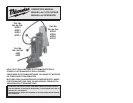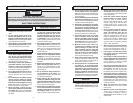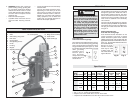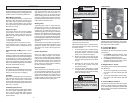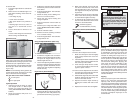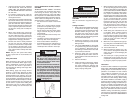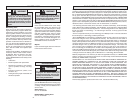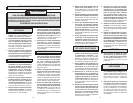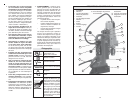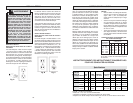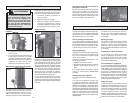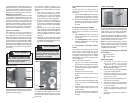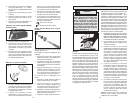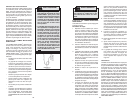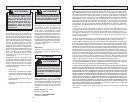
6 7
Grounded tools require a three wire exten-
sion cord. Double insulated tools can use
either a two or three wire extension cord.
As the distance from the supply outlet
increases, you must use a heavier gauge
extension cord. Using extension cords with
inadequately sized wire causes a serious
drop in voltage, resulting in loss of power
and possible tool damage. Refer to the table
shown to determine the required minimum
wire size.
The smaller the gauge number of the wire,
the greater the capacity of the cord. For ex-
ample, a 14 gauge cord can carry a higher
current than a 16 gauge cord. When using
more than one extension cord to make up
the total length, be sure each cord contains
at least the minimum wire size required. If
you are using one extension cord for more
than one tool, add the nameplate amperes
and use the sum to determine the required
minimum wire size.
Guidelines for Using Extension Cords
• If you are using an extension cord out-
doors, be sure it is marked with the suffi x
“W-A” (“W” in Canada) to indicate that it
is acceptable for outdoor use.
• Be sure your extension cord is prop-
erly wired and in good electrical
condition. Always replace a damaged
extension cord or have it repaired by a
qualifi ed person before using it.
• Protect your extension cords from sharp
objects, excessive heat and
damp or wet areas.
READ AND SAVE ALL
INSTRUCTIONS FOR
FUTURE USE.
Recommended Minimum Wire Gauge
for Extension Cords*
Extension Cord Length
* Based on limiting the line voltage drop to
fi ve volts at 150% of the rated amperes.
Nameplate
Amperes
0 - 2.0
2.1 - 3.4
3.5 - 5.0
5.1 - 7.0
7.1 - 12.0
12.1 - 16.0
16.1 - 20.0
25'
18
18
18
18
16
14
12
75'
18
18
16
14
12
10
100'
18
16
14
12
10
150'
16
14
12
12
50'
18
18
18
16
14
12
10
EXTENSION CORDS
WARNING
TOOL ASSEMBLY
To reduce the risk of injury,
always unplug tool before attaching
or removing accessories or making
adjustments. Use only specifi cally
recommended accessories. Others
may be hazardous.
Underwriters
Laboratories, Inc.,
United States and Canada
Symbology
No Load revolutions
per minute (RPM)
Amperes
Volts Alternating Current
Double Insulated
Hertz
DANGER! To reduce the
risk of injury, always keep
hands, rags, clothing, etc.
away from moving parts
and chips. Do not try to
remove chips while the
cutter is rotating. Chips are
sharp and can pull objects
into moving parts.
1. Assemble the feed handles and grips to
the feed handle hub. Tighten securely.
2. To mount the feed handle to the opposite
side, remove the wing screw assembly
that secures the hub/pinion assembly.
Pull out the hub/pinion assembly and
insert on the other side of the housing.
Replace and tighten the wing screw
assembly.
Mounting the Drill on Slide
Attaching Feed Handles and Grips
To adjust the gib, loosen or tighten the gib
adjustment set screws on the side of the
support housing accordingly with the 3/32"
hex key provided. Tightening the set screws
increases friction on the slide. The gib should
be set tight enough to support the weight of
the drill in any position. All adjusting screws
should be set to provide smooth and even
travel over the entire length of slide move-
ment.
The set screws contain a nylon patch that
prevents them from moving freely. Additional
adjustment of the gib may be required from
time to time with extended use of the tool.
Connecting the Power Cord Control Panel
Socket
To provide maximum holding power, mount
the motor with the spindle closest to the
stand. All drills (except 4253-1) can also
be mounted in a reverse position to permit
drilling close to walls and corners. When the
spindle is furthest from the stand, the maxi-
mum drill point pressure is reduced.
Insert the drill plug into the control panel
socket and screw it on tightly. Plug the drill
press into the nearest power source. This drill
press is rated for 120 volts AC, 60 Hz.
Fig. 2
Fig. 3
Fig. 4
Fig. 1
1. Select the mounting area that best suits
your application.
2. Line up the mounting holes.
3. Slip the lock washers over the mounting
screw and insert them through the back
of the slide and into the motor mounting
pad. Tighten securely.
Adjusting the Gib Assembly



